Nutrition-Sensitive Homestead Pond Polyculture Technology Empowers Women in Rural Bangladesh
Abstract
1. Introduction
Study Context
2. Materials and Methods
2.1. Training and Data Collection
2.2. Data Management and Statistical Analysis
3. Results
3.1. Type of Fish Production Technology Practiced by Households
3.2. Frequency of Fish Harvesting for Family Consumption
3.3. Frequency of Harvesting Fish for Sale
3.4. Decision Making on the Type of Fish Species to Be Cultured
3.5. Decision Making on Time of Harvesting Fish for Sale
3.6. Decision-Making over Types of Fish to Harvest for Family Consumption
3.7. Person Harvesting Fish for Family Consumption
3.8. Person Deciding Which Foods to Purchase for Family Consumption
4. Discussion
4.1. Practical Implication of the Study
4.2. Research Significance
4.3. Policy Implications of the Study
4.4. Policy Recommendations
5. Conclusions
Author Contributions
Funding
Institutional Review Board Statement
Informed Consent Statement
Data Availability Statement
Acknowledgments
Conflicts of Interest
References
- Ahmed, M.K.; Sadeka, H.; Shamima, S. Participation of women in aquaculture in three coastal districts of Bangladesh: Approaches toward sustainable livelihood. World J. Agric. Sci. 2012, 8, 253–268. [Google Scholar]
- Verhart, N.; van den Wijngaart, A.; Dhamankar, M.; Danielsen, K. Bringing agriculture and nutrition together. AIDS 2015, 30, 1403-1311. [Google Scholar] [CrossRef]
- Akter, S.; Rutsaert, P.; Luis, J.; Htwe, N.M.; San, S.S.; Raharjo, B.; Pustika, A. Women’s empowerment and gender equity in agriculture: A different perspective from Southeast Asia. Food Policy 2017, 69, 270–279. [Google Scholar] [CrossRef]
- Food and Agriculture Organization. Gender in Fisheries and Aquaculture. Available online: https://www.fao.org/gender/learning-center/thematic-areas/gender-in-fisheries-and-aquaculture/en (accessed on 19 June 2025).
- Akter, S.; Krupnik, T.J.; Rossi, F.; Khanam, F. The influence of gender and product design on farmers’ preferences for weather-indexed crop insurance. Glob. Environ. Change 2016, 38, 217–229. [Google Scholar] [CrossRef]
- Anderson, C.; Tiitii, U.; Madar, L.; Tanielu, E.; Larson, S.; Swanepoel, L. Unpacking gendered roles across the seaweed value chain in Samoa using photo elicitation methods. Ocean. Coast. Manag. 2023, 232, 106420. [Google Scholar] [CrossRef]
- Adam, R.; Lam, R.D.; Lozano Lazo, D.P.; McDougall, C.; Rajaratnam, S.; Ouko, K.; Rossignoli, C.M. Using a sustainable food systems framework to examine gender equality and women’s empowerment in aquatic food systems. Front. Sustain. Food Syst. 2024, 8, 1327798. [Google Scholar] [CrossRef]
- Maertens, M.; Verhofstadt, E. Horticultural Exports Female Wage Employment and Primary School Enrolment: Theory and Evidence from Senegal. Food Policy 2013, 43, 118–131. [Google Scholar] [CrossRef]
- Richards, E.; Tolhurst, R.; Theobald, S. Gender Influences A Narrative Review on Child Survival, Health and Nutrition; United Nations Children’s Fund (UNICEF): New York, NY, USA, 2011. [Google Scholar]
- Galiè, A.; Teufel, N.; Girard, A.W.; Baltenweck, I.; Dominguez-Salas, P.; Price, M.J.; Jones, R.; Lukuyu, B.; Korir, L.; Raskind, I.; et al. Women’s empowerment, food security and nutrition of pastoral communities in Tanzania. Glob. Food Sec. 2019, 23, 125–134. [Google Scholar] [CrossRef]
- Sraboni, E.; Malapit, H.J.; Quisumbing, A.R.; Ahmed, A.U. Women’s empowerment in agriculture: What role for food security in Bangladesh? World Dev. 2014, 61, 11–52. [Google Scholar] [CrossRef]
- Harper, S.; Zeller, D.; Hauzer, M.; Pauly, D.; Sumaila, U.R. Women and fisheries: Contribution to food security and local economies. Mar. Policy 2013, 39, 56–63. [Google Scholar] [CrossRef]
- SPRING Project. Understanding the Women’s Empowerment Pathway; Improving Nutrition through Agriculture Technical Brief Series, Brief #4; Strengthening Partnerships, Results, and Innovations in Nutrition Globally (SPRING), JSI Research & Training Institute, Inc.: Arlington, VA, USA, 2014. [Google Scholar]
- Smith, L.C.; Ramakrishnan, U.; Ndiaye, A.; Haddad, L.; Martorell, R. The importance of women’s status for child nutrition in developing countries. Food Nutr. Bull. 2003, 24, 287–288. [Google Scholar] [CrossRef] [PubMed]
- Galiè, A.; Jiggins, J.; Struik, P.C.; Grando, S.; Ceccarelli, S. “Women’s empowerment through seed improvement and seed governance: Evidence from participatory barley breeding in pre-war Syria”. NJAS—Wagening. J. Life Sci. 2017, 81, 1–8. [Google Scholar] [CrossRef]
- FAO. Women in agriculture: Closing the gender gap for development. In The State of Food and Agriculture; FAO: Rome, Italy, 2011. [Google Scholar] [CrossRef]
- Gates, M.F. Putting women and girls at the center of development. Science 2014, 345, 1273–1275. [Google Scholar] [CrossRef] [PubMed]
- World Bank. World Development Report 2012: Gender Equality and Development; World Bank: Washington, DC, USA, 2012. [Google Scholar]
- WFP; FAO; UNICEF. Role of Food Security and Nutrition Interventions in Empowering Women; FAO: Dhaka, Bangladesh, 2013. [Google Scholar]
- Choudhury, A.; Mcdougall, C.L.; Rajaratnam, S. Women’s Empowerment in Aquaculture: Two Case Studies from Bangladesh. 2017. Available online: https://www.researchgate.net/publication/319477804 (accessed on 1 November 2025).
- Food and Agriculture Organization. Women’s Empowerment in Aquaculture in Bangladesh and Indonesia: Insights from Four Case Studies Background: Women in Aquaculture in Bangladesh and Indonesia; Food and Agriculture Organization: Rome, Italy, 2017. [Google Scholar]
- Matovu, B.; Bleischwitz, R.; Alkoyak-Yildiz, M.; Arlikatti, S. Invigorating women’s empowerment in marine fishing to promote transformative cultures and narratives for sustainability in the blue economy: A scoping literature review from the Global South. Mitig. Adapt. Strat. Glob. Chang. 2024, 29, 83. [Google Scholar] [CrossRef]
- Consultative Group for International Agricultural Research (CGIAR). Closing the gender gap in agriculture. Gender and Agriculture Research Network; Consultative Group for International Agricultural Research (CGIAR): Washington, DC, USA, 2016. [Google Scholar]
- Njogu, L.; Adam, R.; Farnworth, C.R. Assessing women’s empowerment, participation, and engagement in aquaculture in Bangladesh. Aquac. Int. 2024, 32, 6303–6331. [Google Scholar] [CrossRef]
- Ishita, I.J. Sustainability of Aquaculture and its Impact on Rural Women of Bangladesh; North South University: Dhaka, Bangladesh, 2019. [Google Scholar]
- Kruijssen, F.; Adam, R.; Choudhury, A.; Danielsen, K.; McDougall, C.L.; Newton, J.; Smits, E.; Shelley, C. A Gendered Aquaculture Value Chain Analysis in Northwestern Bangladesh; USAID: Washington, DC, USA, 2021.
- Yu, B. From Plot to Plate: Linking Agricultural Productivity and Human Nutrition in Bangladesh. In Proceedings of the International Association of Agricultural Economists, Foz do Iguacu, Brazil, 18–24 August 2012. [Google Scholar]
- Parasuraman, S.; Rajaretnam, T. Agriculture, food security and nutrition in Vidarbha: A household level analysis. Econ. Polit. Wkly. 2011, 46, 42–50. [Google Scholar]
- Feed the Future, the U.S. Government’s Global Hunger and Food Security Initiative. Available online: https://www.feedthefuture.gov/about/ (accessed on 18 September 2019).
- Herforth, A.; Harris, J. Improving Nutrition through Agriculture Technical Brief Series: Understanding and Applying Primary Pathways and Principles; USAID/Strengthening Partnerships, Results, and Innovations in Nutrition Globally (SPRING) Project: Arlington, VA, USA, 2014.
- WorldFish. Gender and Aquaculture: Sharing the Benefits Equitably; WorldFish: Penang, Malaysia, 2011. [Google Scholar]
- Belton, M.B.; Karim, M.; Thilsted, S.; Murshed-E-Jahan, K.; Collis, W.; Phillips, M. Review of Aquaculture & Fish Consumption in Bangladesh Review of Aquaculture and Fish Consumption in Bangladesh; WorldFish: Penang, Malaysia, 2011. [Google Scholar]
- Castine, S.A.; Bogard, J.R.; Barman, B.K.; Karim, M.; Hossain, M.; Kunda, M.; Mahfuzul Haque, A.B.M.; Phillips, M.J.; Thilsted, S.H. Homestead pond polyculture can improve access to nutritious small fish. Food Secur. 2017, 9, 785–801. [Google Scholar] [CrossRef]
- Bangladesh Bureau of Statistics (BBS). Preliminary Report on Households Income and Expenditure Survey 2016; Bangladesh Bureau of Statistics (BBS): Dhaka, Bangladesh, 2017.
- Akter, R.; Thilsted, S.H.; Hossain, N.; Ishihara, H.; Yagi, N. Fish is the Preferred Animal-Source Food in the Rural Community of Southern Bangladesh. Sustainability 2019, 11, 5764. [Google Scholar] [CrossRef]
- FAO/WHO. Bangladesh Country Paper—Second International Conference on Nutrition (ICN2); FAO: Rome, Italy, 2014. [Google Scholar]
- Headey, D.D.; Hirvonen, K.; Hoddinott, J.F. Animal Sourced Foods and Child Stunting. IFPRI Discussion Paper 1695; International Food Policy Research Institute: Washington, DC, USA, 2017. [Google Scholar]
- Roos, N.; Islam, M.M.; Thilsted, S.H. Small Indigenous Fish Species in Bangladesh: Contribution to Vitamin A, Calcium and Iron Intakes. J. Nutr. 2003, 133, 4021S–4026S. [Google Scholar] [CrossRef]
- Shaheen, N.; Rahim, A.T.M.A.; Mohiduzzaman; Banu, C.P.; Bari, L.; Tukun, A.B.; Mannan, M.A.; Bhattacharjee, L.; Stadlmayr, B. Food Composition Table for Bangladesh; Institute of Nutrition and Food Science, Center for Advanced Research and in Sciences: Dhaka, Bangladesh, 2014. [Google Scholar]
- Bogard, J.R.; Thilsted, S.H.; Marks, G.C.; Wahab, M.A.; Hossain, M.A.R.; Jakobsen, J.; Stangoulis, J. Nutrient composition of important fish species in Bangladesh and potential contribution to recommended nutrient intakes. J. Food Compos. Anal. 2015, 42, 120–133. [Google Scholar] [CrossRef]
- ICDDR’B, UNICEF, Bangladesh, GAIN. Final Report: National Micronutrients Status Survey 2011-12; Ministry of Health and Family Welfare, Government of the People’s Republic of Bangladesh: Dhaka, Bangladesh, 2014. [Google Scholar]
- Milstein, A.; Wahab, M.A.; Kadir, A.; Sagor, M.F.H.; Islam, M.A. Effects of intervention in the water column and/or pond bottom through species composition on polycultures of large carps and small indigenous species. Aquaculture 2009, 286, 246–253. [Google Scholar] [CrossRef]
- CGIAR. Common Gender & Empowerment IDO. CGIAR Gender and Agriculture Research Network; CGIAR: Montpellier, France, 2014. Available online: https://hdl.handle.net/10947/3171 (accessed on 18 September 2019).
- Izuchukwu, A.; Erezi, E.; Emeka, E.D. Assessing the Impact of Farmer-to-Farmer Communication Networks on Knowledge Sharing and Adoption of Sustainable Agricultural Practices in Africa. Int. J. Agric. Earth Sci. 2023, 9, 58–76. [Google Scholar] [CrossRef]
- Jahan, K.M.; Belton, B.; Hazrat, A.; Goutam, C.D.; Ara, I. Aquaculture Technologies in Bangladesh: An Assessment of Technical and Economic Performance and Producer Behavior; WorldFish: Penang, Malaysia, 2015. [Google Scholar] [CrossRef]
- WorldFish. Polyculture of Carps and Mola in Ponds and Ponds Connected to Rice Fields; WorldFish: Penang, Malaysia, 2014. [Google Scholar]
- Roos, N. Fish Consumption and Aquaculture in Rural Bangladesh: Nutritional Contribution and Production Potential of Culturing Small Indigenous Fish Species (SIS) in Pond Polyculture with Commonly Cultured Carps. Ph.D. Thesis, Royal Veterinary and Agricultural University, Copenhagen, Denmark, 2001. [Google Scholar]
- Parrao, C.G.; Shisler, S.; Moratti, M.; Yavuz, C.; Acharya, A.; Eyers, J.; Snilstveit, B. Aquaculture for improving productivity, income, nutrition and women’s empowerment in low- and middle-income countries: A systematic review and meta-analysis. Campbell Syst. Rev. 2021, 17, e1195. [Google Scholar] [CrossRef]
- Ahmmed, A.U.; Nahiduzzaman, M.; Sayeed, M.A.; Akter, M.; Hossain, M.A.R. Consumption pattern of small indigenous species (SIS) of fish with special emphasis on mola (Amblypharyngodon mola) among growers and non-growers level. J. Agrofor. Environ. 2008, 2, 167–170. [Google Scholar]
- James P Grant School of Public Health and National Nutrition Services. State of food security and nutrition in Bangladesh 2015; James P Grant School of Public Health and National Nutrition Services: Dhaka, Bangladesh, 2016. [Google Scholar]
- Thorne-Lyman, A.L.; Valpiani, N.; Akter, R.; Baten, A.; Genschick, S.; Karim, M.; Thilsted, S.H. Fish and Meat Are Often Withheld From the Diets of Infants 6 to 12 Months in Fish-Farming Households in Rural Bangladesh. Food Nutr. Bull. 2017, 38, 354–368. [Google Scholar] [CrossRef]
- Castro, A.F. An Approach to the Food Habits of Three Communities in Timor-Leste; Care International Timor-Leste: Dili, Timor-Leste, 2013. [Google Scholar]
- Stellmacher, T.; Kelboro, G. Family Farms, Agricultural Productivity, and the Terrain of Food (In)security in Ethiopia. Sustainability 2019, 11, 4981. [Google Scholar] [CrossRef]
- Janči, T.; Putnik, P. Sustainable fish production: Aquaculture systems and environmental impacts. In Environmental Remediation in Agri-Food Industry Using Nanotechnology and Sustainable Strategies; Academic Press: New York, NY, USA, 2025; pp. 7–22. [Google Scholar] [CrossRef]
- Herforth, A.; Ahmed, S. The food environment, its effects on dietary consumption, and potential for measurement within agriculture-nutrition interventions. Food Secur. 2015, 7, 505–520. [Google Scholar] [CrossRef]
- Wahab, M.; Kadir, A.; Milstein, A.; Kunda, M. Manipulation of species combination for enhancing fish production in polyculture systems involving major carps and small indigenous fish species. Aquaculture 2011, 321, 289–297. [Google Scholar] [CrossRef]
- E-Jahan, K.M.; Ahmed, M.; Belton, B. The impacts of aquaculture development on food security: Lessons from Bangladesh. Aquac. Res. 2010, 41, 481–495. [Google Scholar] [CrossRef]
- Faruque, G. An Exploration of Impacts of Aquaculture Production and Marketing on Rural Livelihoods in Three Regions in Bangladesh. Ph.D. Thesis, University of Stirling, Stirling, UK, 2007. [Google Scholar]
- Webb, P. Impact Pathways from Agricultural Research to Improved Nutrition and Health: Literature Analysis and Research Priorities; Food and Agriculture Organization of the United Nations: Rome, Italy, 2013. [Google Scholar] [CrossRef]
- Alkire, S.; Meinzen-Dick, R.; Peterman, A.; Quisambing, A.R.; Seymour, G.; Vez, A. The Women’s Empowerment in Agriculture Index; OPHI Working Paper No. 58. Oxford Poverty & Human Development Initiative, University of Oxford: Oxford, UK, 2013. [Google Scholar]
- Akhtar, S. Contributions of women in the agriculture sector of Bangladesh. CGIAR GENDER Platform annual conference 2023. Poster. In Proceedings of the CGIAR GENDER Conference “From Research to Impact: Towards Just and Resilient Agri-Food Systems”, New Delhi, India, 9–12 October 2023. [Google Scholar]
- Chakma, K.; Ruba, U.B. Role of Bangladeshi Women in Diverse Agricultural Production: A Review. Eur. J. Agric. Food Sci. 2021, 3, 1–5. [Google Scholar] [CrossRef]
- Dupuis, S.; Hennink, M.; Wendt, A.S.; Waid, J.L.; Kalam, A.; Gabrysch, S.; Sinharoy, S.S. Women’s empowerment through homestead food production in rural Bangladesh. BMC Public Health 2022, 22, 134. [Google Scholar] [CrossRef] [PubMed]
- Samina Shirajee, S.; Salehin, M.M.; Ahmed, N. The changing face of women for small scale aquaculture development in rural Bangladesh. Aquac. Asia Mag. 2012, 15, 9–16. [Google Scholar]
- Farnworth, C.R.; Sultana, N.; Kantor, P.; Choudhury, A. Gender Integration in Aquaculture Research and Technology Adoption Processes: Lessons Learned in Bangladesh; WorldFish: Penang, Malaysia, 2015. [Google Scholar]
- FAO. The State of World Fisheries and Aquaculture 2022; FAO: Rome, Italy, 2022. [Google Scholar] [CrossRef]

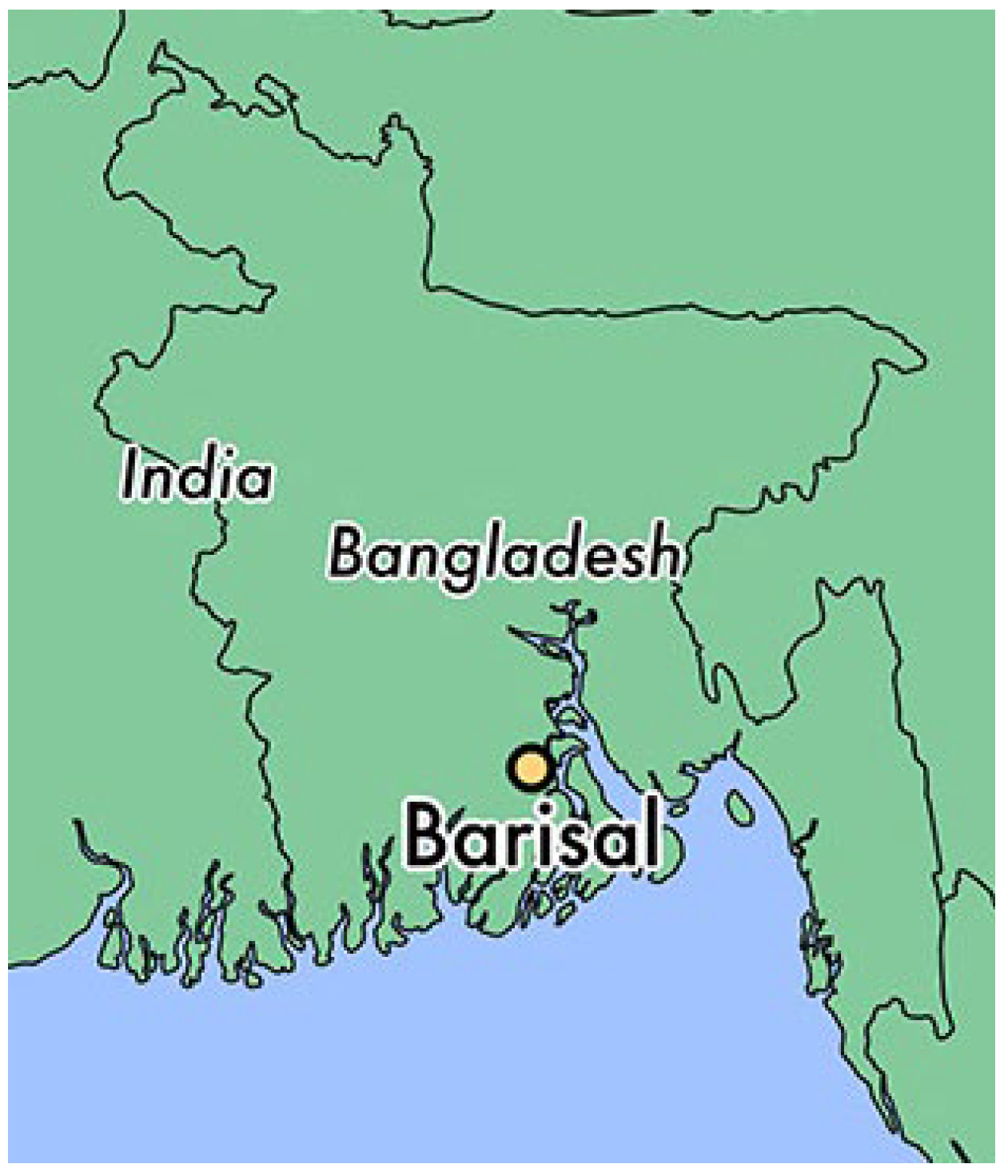

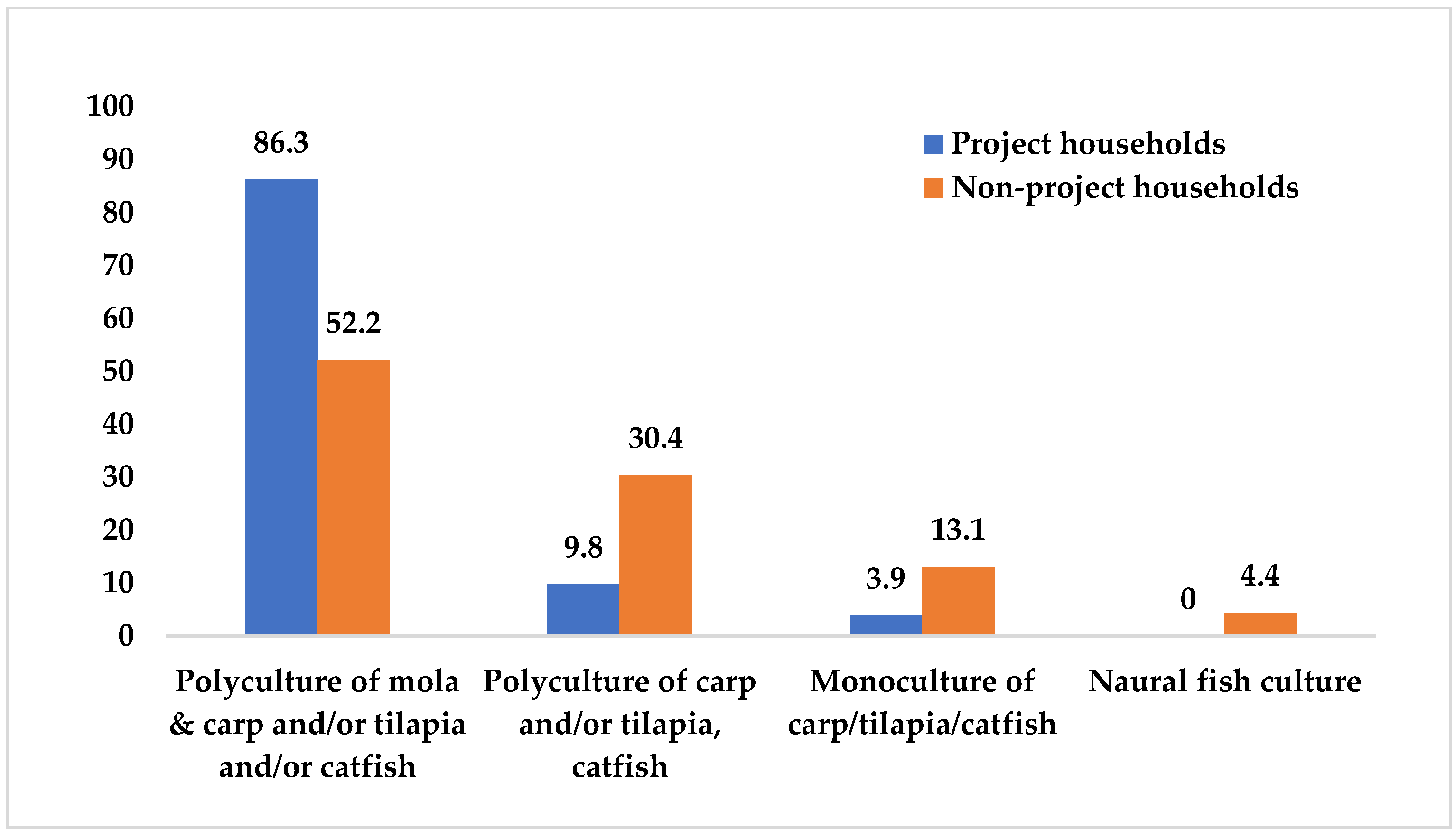
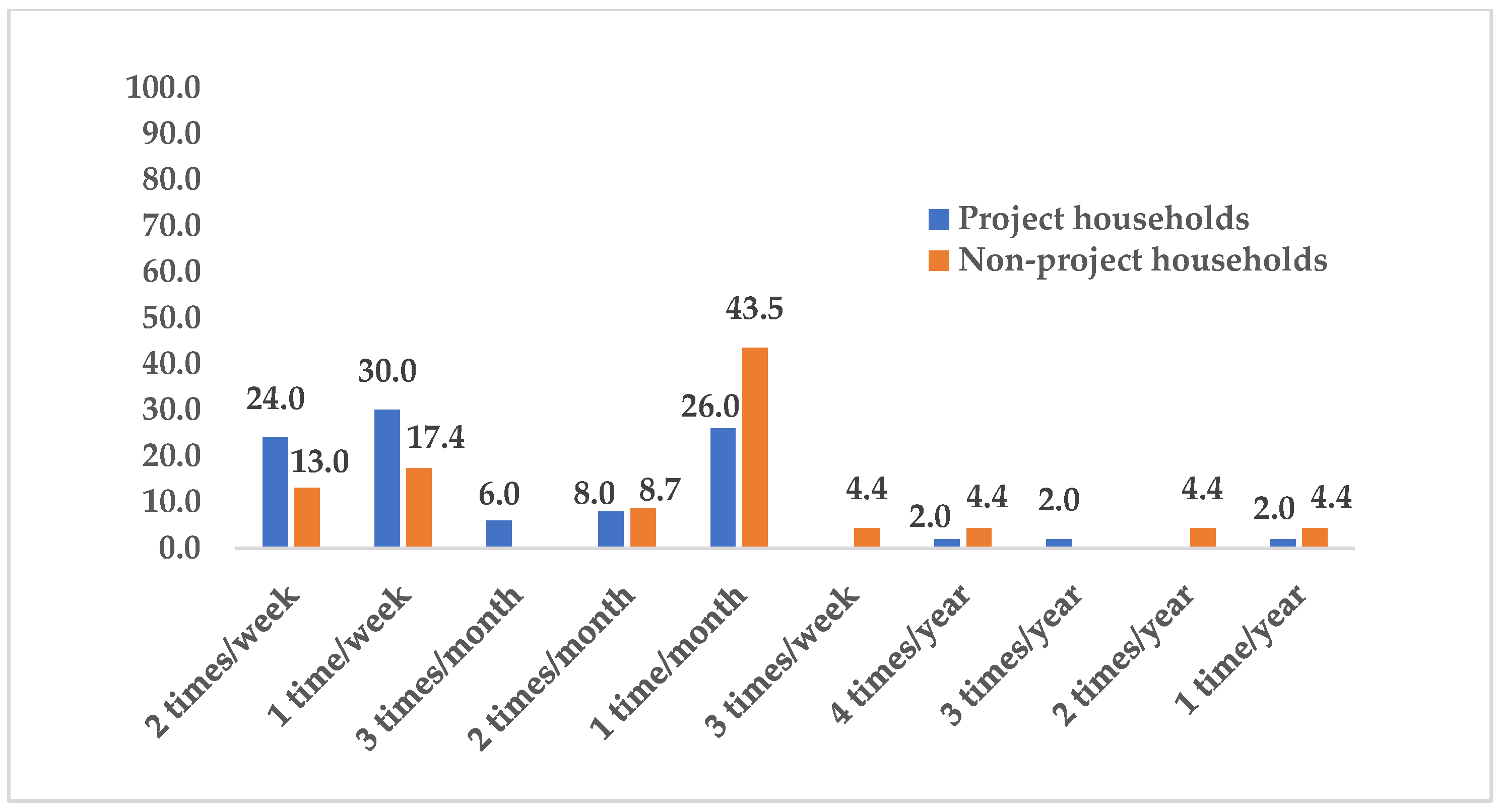
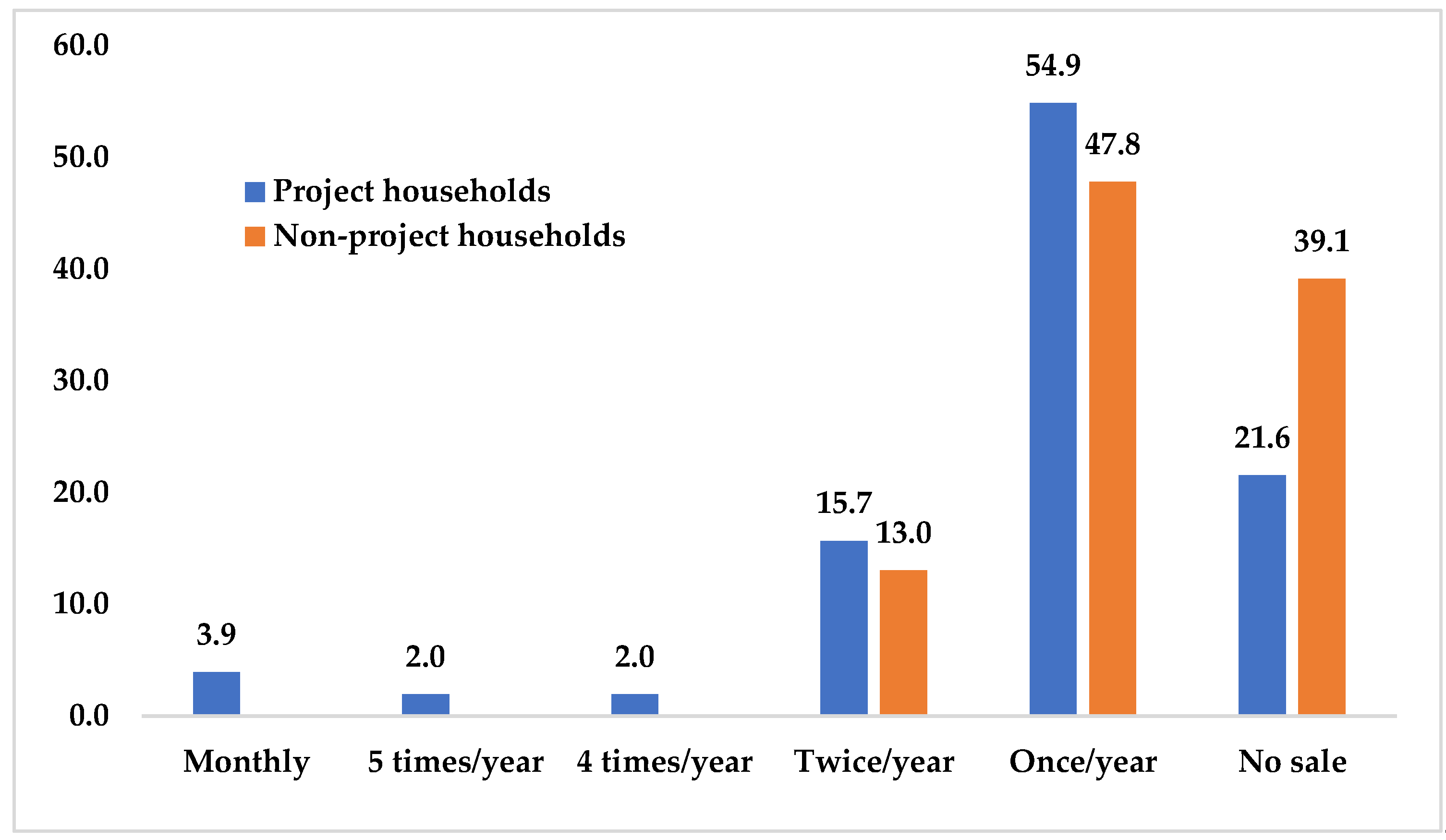
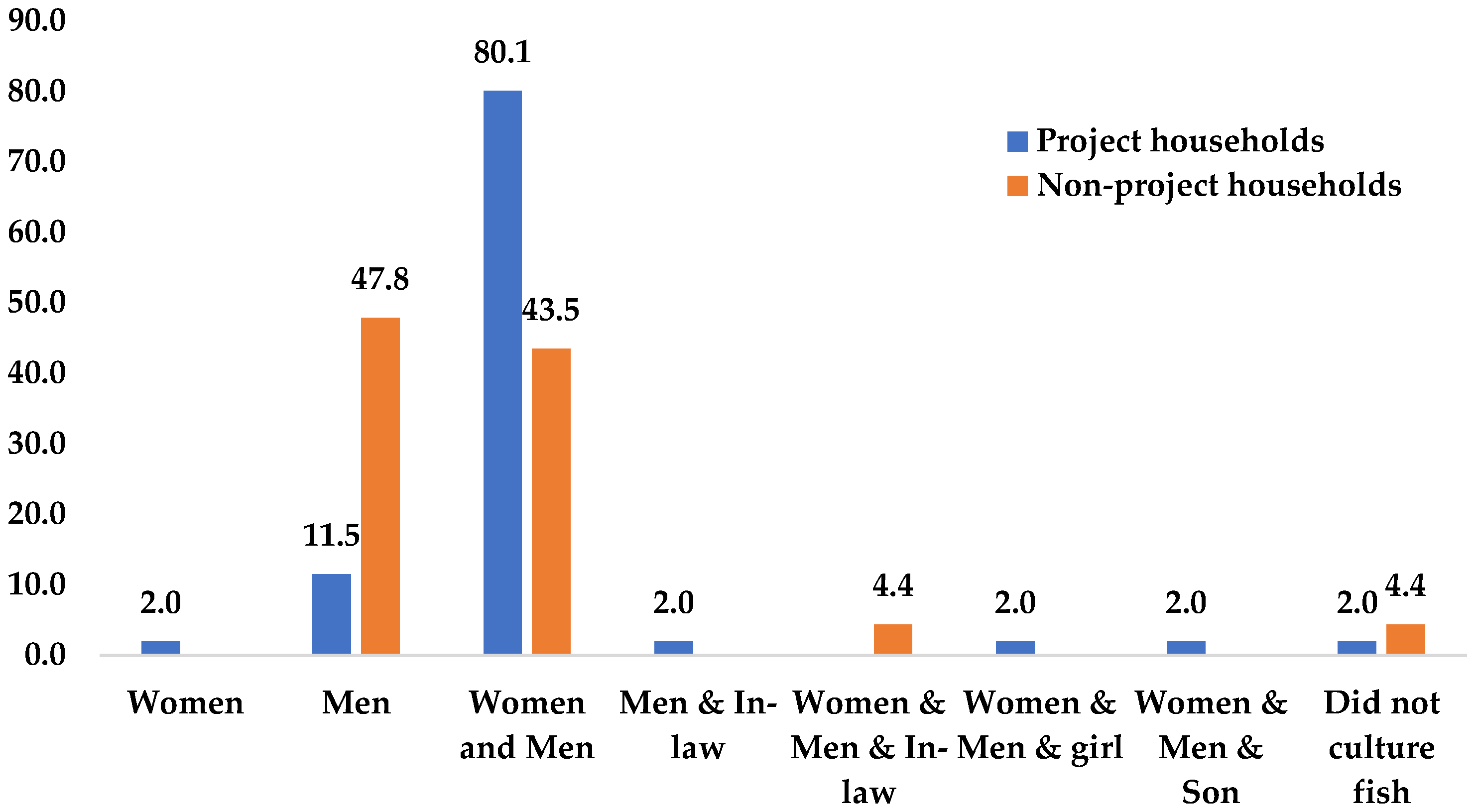
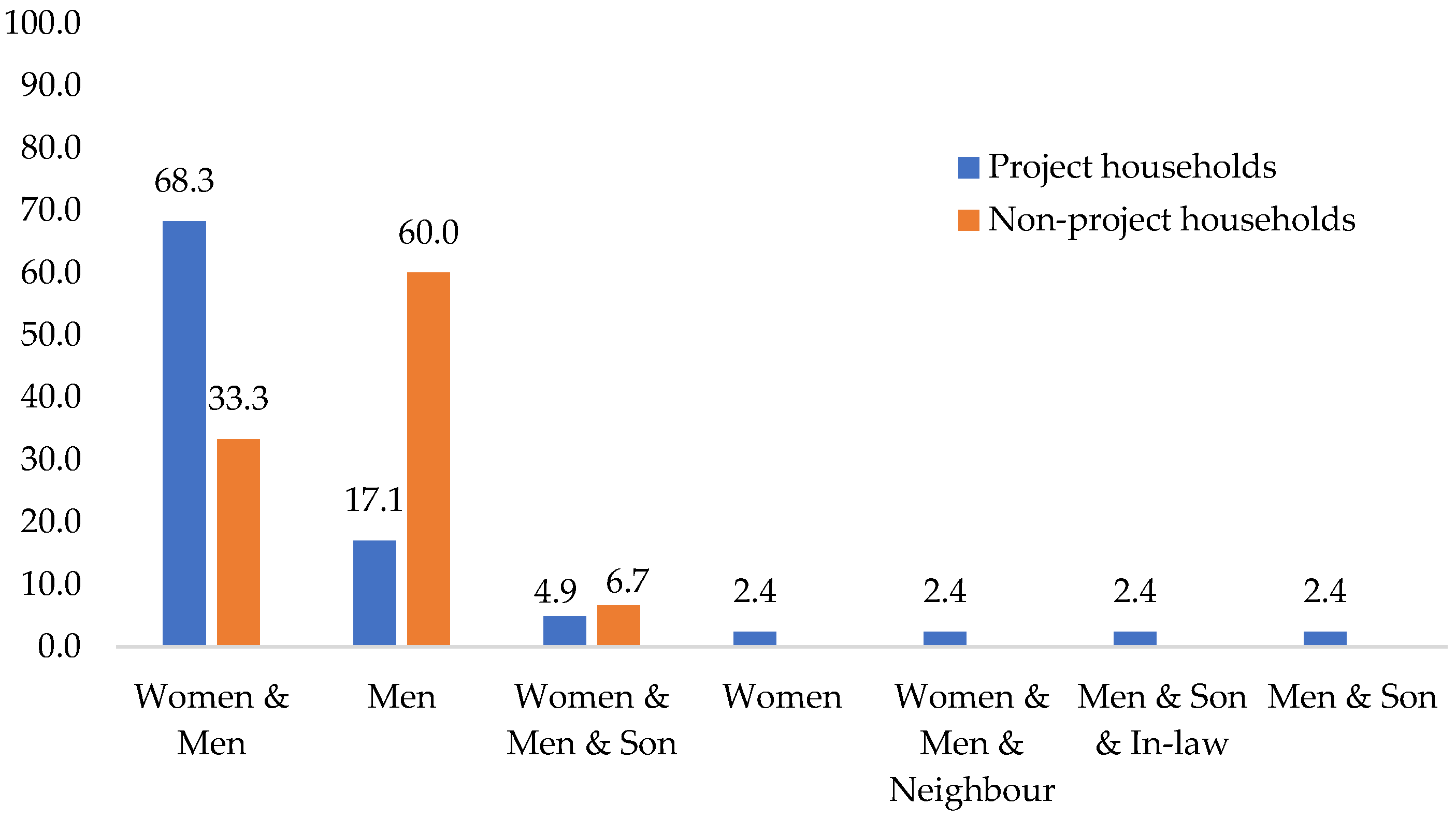



Disclaimer/Publisher’s Note: The statements, opinions and data contained in all publications are solely those of the individual author(s) and contributor(s) and not of MDPI and/or the editor(s). MDPI and/or the editor(s) disclaim responsibility for any injury to people or property resulting from any ideas, methods, instructions or products referred to in the content. |
© 2025 by the authors. Licensee MDPI, Basel, Switzerland. This article is an open access article distributed under the terms and conditions of the Creative Commons Attribution (CC BY) license (https://creativecommons.org/licenses/by/4.0/).
Share and Cite
Akter, R.; Thilsted, S.H.; Yagi, N. Nutrition-Sensitive Homestead Pond Polyculture Technology Empowers Women in Rural Bangladesh. Sustainability 2025, 17, 10564. https://doi.org/10.3390/su172310564
Akter R, Thilsted SH, Yagi N. Nutrition-Sensitive Homestead Pond Polyculture Technology Empowers Women in Rural Bangladesh. Sustainability. 2025; 17(23):10564. https://doi.org/10.3390/su172310564
Chicago/Turabian StyleAkter, Rumana, Shakuntala H. Thilsted, and Nobuyuki Yagi. 2025. "Nutrition-Sensitive Homestead Pond Polyculture Technology Empowers Women in Rural Bangladesh" Sustainability 17, no. 23: 10564. https://doi.org/10.3390/su172310564
APA StyleAkter, R., Thilsted, S. H., & Yagi, N. (2025). Nutrition-Sensitive Homestead Pond Polyculture Technology Empowers Women in Rural Bangladesh. Sustainability, 17(23), 10564. https://doi.org/10.3390/su172310564






